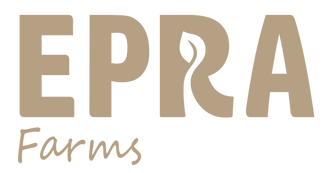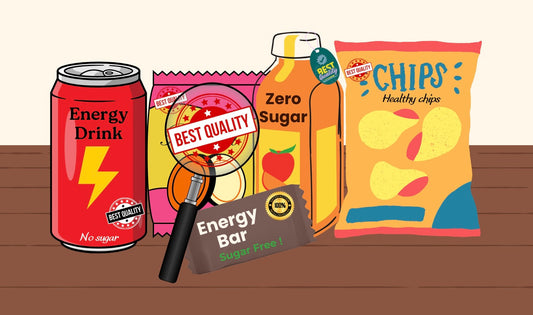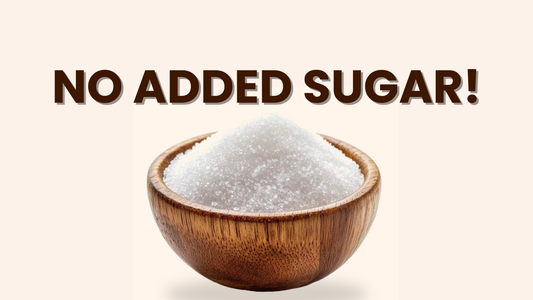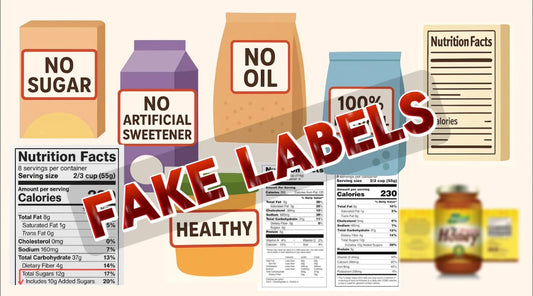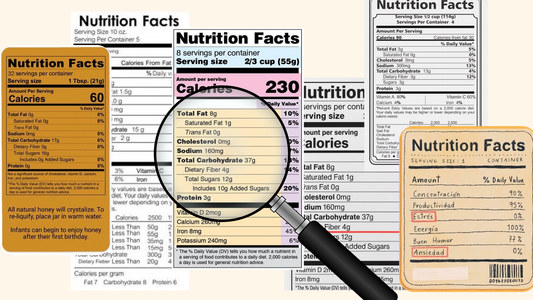Introduction: Why You See Strange Codes on Food Labels
Have you ever flipped a packet of chips or a soft drink and seen something like:
-
E150d
-
INS 330
-
E202
It looks more like chemistry class than food. These are called E-numbers (or INS numbers in India - International Numbering System). They represent additives: preservatives, colorings, flavor enhancers, stabilizers.
👉 Not all additives are bad. Some are harmless (like vitamin C as a preservative). But some raise red flags - linked to hyperactivity in kids, gut problems, or even cancer risk when overused.
This blog will help you understand which E-numbers matter, which are safe, and which you should avoid.
Chapter 1: What Are E-Numbers and Why Do They Exist?
-
E-numbers were introduced in the EU (hence “E”) to standardize additive names.
-
In India, labels often use INS numbers (same system).
-
Purpose: food safety and consistency. Instead of writing “butylated hydroxyanisole,” the label just says E320.
Why Are Additives Used?
-
Preservation - to stop spoilage (E200–E299).
-
Color - to make food look attractive (E100–E199).
-
Flavor & sweetness - to enhance taste (E600–E699, E900+).
-
Texture - stabilizers, emulsifiers, thickeners (E400–E499).
👉 Without additives, packaged food wouldn’t survive weeks in supermarkets. But not all additives are equal.
Chapter 2: The Big Categories of E-Numbers
1. Preservatives (E200-E299)
-
Common examples:
-
E211 (sodium benzoate – in soft drinks).
-
E202 (potassium sorbate – in jams, juices).
-
E220 (sulphur dioxide – in dried fruits).
-
Concerns: hyperactivity in children, allergic reactions, gut irritation.
2. Colors (E100-E199)
-
Natural colors:
-
E100 (curcumin – turmeric extract).
-
E160a (beta-carotene – from carrots).
-
Artificial colors:
-
E102 (tartrazine – yellow).
-
E110 (sunset yellow).
-
E129 (allura red).
-
Concerns: artificial colors linked to hyperactivity, behavioral issues in kids (“E-number syndrome”).
3. Sweeteners (E900s)
-
Examples:
-
E950 (acesulfame K).
-
E951 (aspartame).
-
E955 (sucralose).
-
E960 (stevia).
-
Concerns: artificial sweeteners may disrupt gut microbiome; aspartame has been controversial.
4. Emulsifiers & Stabilizers (E400–E499)
-
Examples:
-
E412 (guar gum).
-
E415 (xanthan gum).
-
E471 (mono- and diglycerides of fatty acids).
-
Mostly safe - but some (E471 from hydrogenated oils) may contribute to trans fats.
5. Flavor Enhancers (E600-E699)
-
Famous one: E621 (monosodium glutamate – MSG).
-
Used in: instant noodles, chips, soups.
-
Concern: “Chinese restaurant syndrome” (headache, flushing) though evidence is mixed.
Chapter 3: The Red-Flag Additives
Here are the E-numbers you should watch out for in Indian packaged foods:
-
E102 (Tartrazine): Artificial yellow dye, linked to hyperactivity.
-
E110 (Sunset Yellow): Artificial color, allergic reactions in some.
-
E211 (Sodium Benzoate): Preservative; in acidic drinks, may form benzene (carcinogen).
-
E220 (Sulphur Dioxide): Preservative in dried fruits; can trigger asthma.
-
E621 (MSG): Flavor enhancer; safe for most, but some are sensitive.
-
E951 (Aspartame): Artificial sweetener, controversial for headaches and gut health.
👉 Rule of thumb: if your kid eats packaged snacks daily, minimize products with artificial colors and preservatives.
Chapter 4: The Safe Side of Additives
Not all E-numbers are villains. Many are safe and natural.
-
E100 (Curcumin): Extract from turmeric.
-
E160a (Beta-carotene): From carrots.
-
E300 (Ascorbic acid): Vitamin C, used as preservative.
-
E322 (Lecithin): From soy or sunflower, safe emulsifier.
-
E406 (Agar): From seaweed, used in jellies.
👉 If you see these, no need to panic.
Chapter 5: How Additives Sneak Into Indian Diets
-
Kids’ candies and soft drinks = artificial colors (tartrazine, sunset yellow).
-
Juices = sodium benzoate, potassium sorbate.
-
Dried fruits = sulphur dioxide.
-
Biscuits = emulsifiers like E471, preservatives.
-
Instant noodles = MSG + colorings.
👉 Even “immunity-boosting” packaged drinks often contain E-numbers with high sugar.
Chapter 6: The Indian Law (FSSAI Rules)
-
FSSAI follows the Codex Alimentarius & INS system.
-
Additives allowed within limits.
-
Problem: enforcement is weak. Small brands often don’t declare properly.
-
Labels usually list “INS 330” instead of “citric acid.”
👉 Most consumers don’t know what INS/E-numbers mean — so they ignore them.
Chapter 7: How to Read Additives on Labels
-
Flip the pack.
-
Look for “INS” or “E” numbers.
-
If the pack has 6–10 additives, it’s ultra-processed.
-
Learn the red flags (E102, E110, E211, E220, E621, E951).
-
Prefer natural additives (E100, E160a, E300, E322).
👉 Short ingredient lists = better.
Chapter 8: The Monk Fruit Difference
Artificial sweeteners like E951 (aspartame) and E955 (sucralose) dominate the “sugar-free” market. But they come with mistrust.
That’s why monk fruit matters:
-
Sweetness from mogrosides, not artificial chemicals.
-
No E-numbers, no controversies.
-
Natural, zero GI, safe for diabetics.
At EPRA Farms, our monk fruit sweetener is:
-
Monk fruit extract + erythritol (a natural sugar alcohol found in fruits).
-
No synthetic additives.
-
No “sugar-free” gimmicks.
👉 A clean label, easy to trust.
Chapter 9: FAQs
Q: Are all E-numbers bad?
A: No. Many are safe and natural (like E300 = vitamin C). Only some are red flags.
Q: Should I avoid products with any E-numbers?
A: Not always. But if a product has 6+ additives, it’s ultra-processed.
Q: Is MSG really harmful?
A: For most people, no. But some are sensitive (headaches, nausea).
Q: Are natural colors safe?
A: Yes - turmeric, beetroot, beta-carotene are fine.
Q: Why doesn’t India ban harmful additives?
A: Limits exist, but enforcement is weak. Awareness is the first defense.
Conclusion: Which Ones Really Matter
The truth is, additives are a mixed bag. Some are harmless, some are useful, and some should be avoided.
-
Harmless: Vitamin C (E300), turmeric extract (E100), lecithin (E322).
-
Concerning: Tartrazine (E102), sodium benzoate (E211), sulphur dioxide (E220), aspartame (E951).
👉 The rule is simple:
-
If the ingredient list is short and familiar, it’s safer.
-
If it’s long, filled with codes and chemicals, put it back.
Because in the end, the healthiest food rarely comes with an E-number.
